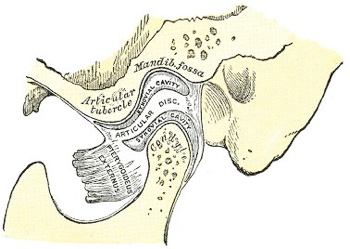TMJ Anatomy


TMJ Anatomy

The temporomandibular joint (TMJ) is an atypical synovial joint located between the condylar process of the mandible and the mandibular fossa and articular eminence of the temporal bone. It is divided into superior discotemporal space and inferior dicomandibular space by the TMJ disc (or meniscus).
The joint is surrounded by a capsule which is attached inferiorly to the head of the condyle (above the pterygoid fovea - attachment of the inferior belly of the lateral pterygoid muscle) and superiorly to the margins of the mandibular fossa (posteriorly) and articular eminence (anteriorly) of the temproal bone.
Laterally it is strengthened by a thickening, the tempromandibular ligament. Between the posterior band of the TMJ disc and the capsule is the retrodiscal zone (aka bilaminar zone).
Normally the disc lies above the condyle, with the junction of the posterior band and intermediate zone within 10 degrees of vertical. Using this measurement however, up to 33% of asymptomatic individuals have displaced discs. Thus some authors suggest using 30 degrees as the cut off to improve specificity.

